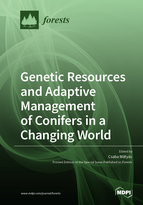Genetic Resources and Adaptive Management of Conifers in a Changing World
A special issue of Forests (ISSN 1999-4907). This special issue belongs to the section "Forest Ecology and Management".
Deadline for manuscript submissions: closed (15 June 2021) | Viewed by 30802
Special Issue Editor
Interests: climate change impacts on forest ecosytems; conservation of genetic resouces; evolutionary ecology; production and use of forest reproductive material; forest genetics and breeding; genetics and improvement of Scots pine
Special Issue Information
Dear Colleagues,
Conifer forests have been widely exploited and transformed by forestry (e.g., by long-range seed trade or selection for cultivation). Around the world, these forests currently display an unexpected vulnerability due to ongoing rapid climatic changes, extreme events, and the invasions of antagonists, which emphasizes the importance of their genetic resources, supporting adaptivity, and resilience. There exists an urgent need to translate research information into frameworks for conserving genetic resources and to support the resilience of conifer species to projected changes and threats. Both ecological and genetic research may significantly contribute to effective dynamic conservation and management strategies.
The planned Special Issue “Genetic Resources and Adaptive Management of Conifers in a Changing World” aims at supporting adaptive management and conservation of conifers by offering a platform for papers presenting new research results or thematic reviews which address knowledge gaps. Thematic fields include conifer genetic diversity or demographics, studies of common gardens or of (epi-)genetic, physiological, and developmental processes during acclimation, evolutionary and plastic responses to abiotic and biotic stress factors, range shifts, etc. Of interest are also issues linked to the ecological and genetic frameworks for restoration and management and to predict growth and survival responses, such as the effects of limiting site factors and extreme events (e.g., droughts), management interventions, and antagonistic organisms on resilience or genetic resources.
Prof. Csaba Mátyás
Guest Editor
Manuscript Submission Information
Manuscripts should be submitted online at www.mdpi.com by registering and logging in to this website. Once you are registered, click here to go to the submission form. Manuscripts can be submitted until the deadline. All submissions that pass pre-check are peer-reviewed. Accepted papers will be published continuously in the journal (as soon as accepted) and will be listed together on the special issue website. Research articles, review articles as well as short communications are invited. For planned papers, a title and short abstract (about 100 words) can be sent to the Editorial Office for announcement on this website.
Submitted manuscripts should not have been published previously, nor be under consideration for publication elsewhere (except conference proceedings papers). All manuscripts are thoroughly refereed through a single-blind peer-review process. A guide for authors and other relevant information for submission of manuscripts is available on the Instructions for Authors page. Forests is an international peer-reviewed open access monthly journal published by MDPI.
Please visit the Instructions for Authors page before submitting a manuscript. The Article Processing Charge (APC) for publication in this open access journal is 2600 CHF (Swiss Francs). Submitted papers should be well formatted and use good English. Authors may use MDPI's English editing service prior to publication or during author revisions.
Keywords
- conifers
- genetic resources and conservation
- climate change impacts
- adaptation to changes
- ecological and genetic limits of resilience
- adaptive management






